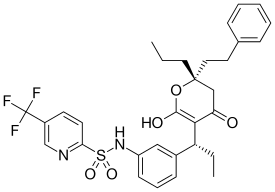Tipranavir
Tipranavir (TPV), or tipranavir disodium, is a nonpeptidic protease inhibitor (PI) manufactured by Boehringer Ingelheim under the trade name Aptivus /ˈæptɪvəs/ AP-tiv-əs. It is administered with ritonavir in combination therapy to treat HIV infection.
 | |
| Clinical data | |
|---|---|
| Pronunciation | /tɪpˈrænəvɪər/ tip-RAN-ə-veer |
| Trade names | Aptivus |
| AHFS/Drugs.com | Monograph |
| MedlinePlus | a606009 |
| License data |
|
| Pregnancy category | |
| Routes of administration | By mouth (soft capsules) |
| ATC code | |
| Legal status | |
| Legal status | |
| Pharmacokinetic data | |
| Protein binding | 99.9% |
| Metabolism | Hepatic |
| Elimination half-life | 4.8–6 hours |
| Excretion | Feces (82.3%), urine (4.4%) |
| Identifiers | |
IUPAC name
| |
| CAS Number | |
| PubChem CID | |
| DrugBank | |
| ChemSpider | |
| UNII | |
| ChEMBL | |
| NIAID ChemDB | |
| PDB ligand | |
| CompTox Dashboard (EPA) | |
| ECHA InfoCard | 100.158.066 |
| Chemical and physical data | |
| Formula | C31H33F3N2O5S |
| Molar mass | 602.66 g/mol g·mol−1 |
| 3D model (JSmol) | |
SMILES
| |
InChI
| |
| | |
Tipranavir has the ability to inhibit the replication of viruses that are resistant to other protease inhibitors and it recommended for patients who are resistant to other treatments. Resistance to tipranavir itself seems to require multiple mutations.[1] Tipranavir was approved by the Food and Drug Administration (FDA) on June 22, 2005, and was approved for pediatric use on June 24, 2008.[2]
Tipranavir should only be taken in combination with ritonavir and other antiretroviral drugs, and is not approved for treatment-naïve patients.[3] Like lopinavir and atazanavir, it is very potent and is effective in salvage therapy for patients with drug resistance. However, side effects of tipranavir may be more severe than those of other antiretrovirals. Some side effects include intracranial hemorrhage, hepatitis, hepatic decompensation, hyperglycemia and diabetes mellitus. The drug has also been shown to cause increases in total cholesterol and triglycerides.[3]
Aptivus labeling has a black box warning regarding hepatotoxicity and intracranial hemorrhage.[3]
References
- Doyon, L; Tremblay, S; Bourgon, L; Wardrop, E; Cordingley, MG (October 2005). "Selection and Characterization of HIV-1 Showing Reduced Susceptibility to the Non-Peptidic Protease Inhibitor Tipranavir". Antiviral Research. 68 (1): 27–35. doi:10.1016/j.antiviral.2005.07.003. PMID 16122817.
- "New Aptivus (tipranavir) Oral Solution Approved for Treatment-Experienced Pediatric and Adolescent HIV Patients" (Press release). Boehringer Ingelheim. 2008-06-24. Retrieved 2008-09-02.
- "Aptivus (tipranavir) Capsules, Oral Solution. Full Prescribing Information" (PDF). Boehringer Ingelheim Pharmaceuticals, Inc.